Disc brakes are awesome because they can slow and even stop a MAMIL-scale mass (ass?) quickly. I have road bikes with rim brakes, and I love the bikes, but their deceleration can at times be too interesting for my likes. I have one bike with 1990 Dia-Compe single-pivot side-pull brakes, and they might as well be painted on for all the stopping power they have.
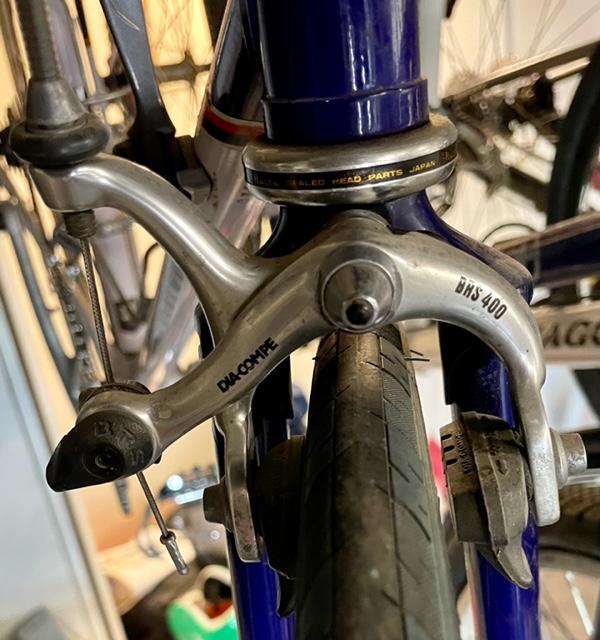
Now that most new road bikes and all gravel bikes have disc, and that the travel gates have been opened, the unwashed hordes of MAMILs with families in tow are filling flights worldwide in search of cycling adventures, or at least something that ‘s not the same crap they’ve ridden since the pandemic landed with a loud thud. Since 2020, they have tuned their bike with parts scavenged from eBay and Craigslist, and as the supply chain begins to ease, some have even put brand new parts on the bike. Given this 24-month upgrade timeframe, is it any wonder they want to bring their pride-and-joy along? I say, “No, of course not. Your bike needs a vacation too.”
I’ve covered travel cases in other posts, and if you, dear reader, are suffering from either insomnia or terminal boredom at work, I recommend you study up. It’s not like you’ve had a recent uptick in productivity, after all.
There are essentially two flavors of disc brake caliper: wet and dry. Dry calipers are cable-actuated and work with a standard brake lever. They are generally easy to use and set up, and beyond pad replacement, there is not a huge amount of maintenance. Several versions exist, but the most common and best performing are Avid BB-7, Tektro MD-C550, TRP Hy-RD, Yokozuna (or Juin-Tech) Motoko and Ultimo, and Paul Klampers. CyclingTips published a good explanation of the pros and cons of mechanical brakes, it’s worth a read.
On my family’s disc bike fleet, we have several pairs of the Yokozuna/Juin-Tech Motoko (2-piston) or Ultimo (4-piston) cable-actuated-hydraulic calipers. Yokozuna ships with compressionless cable housing and rotors, while the Juin-Tech ships as caliper only. Other than that, they are the same critter. I am a fan of these brakes, and although they are not quite as good as my SRAM hydraulic calipers, they are much better than the BB-7s I had before. I use the Ultimo 4-piston on my singlespeed and my fatbike with Paul cantilever levers, and have had no issues whatsoever. Both versions use readily-available Shimano compatible pads.
The obvious benefit of a travel bike with cable-actuated brakes (disc or rim) is that you can use a cable-coupler to set it up for disassembly. If you’ve ever tried to cram a bike into a travel case, you know that the biggest hassle is the handlebars and the attached cables; in an all-cable bike couplers will solve this issue fairly easily and inexpensively.
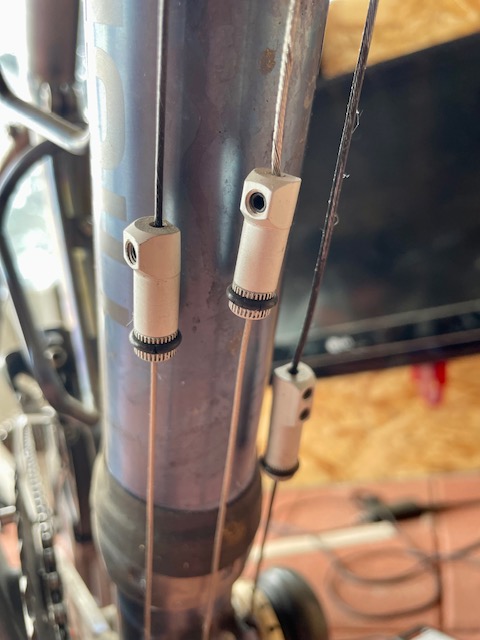
If you have hydraulic (wet) brakes, however, you are now in a bind unless you are very good at puzzles and avoiding twisting the hoses. If your bike uses external hose routing and IS-mount calipers (the bolts are horizontal and go into a bracket that holds the caliper), you can usually pop the whole caliper off by removing the IS bolts, because the vertical bolts that hold the caliper to the bracket will preserve the brake alignment. Most bikes in the last 8 years or more use post-mount, so even though you can easily remove the caliper, you will need to re-align it to the rotor in your hotel room.
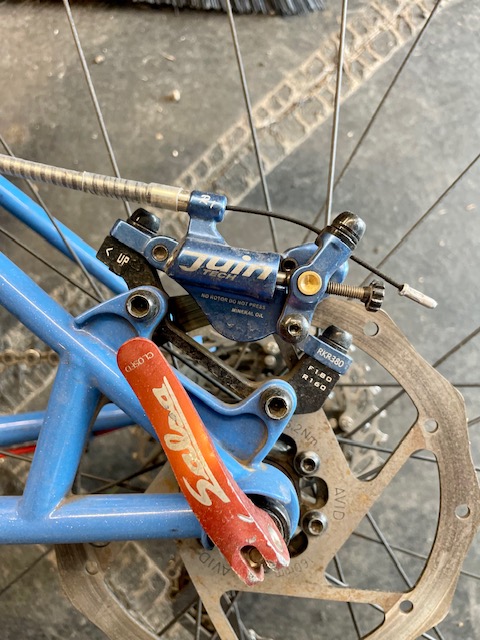
Or, you are using a BuxomBox or SciCon case that leaves the bars in place.
The solution I found for hydraulic brakes is the Formula Speedlock hose kit. The design is kind of like a tiny air compressor hose, with a spring-loaded collar and ball-bearing seal. It is offered in both mineral oil (Shimano) and DOT (SRAM) versions. Given that my only Shimano grouppo in the house is an all-original Deer Head, complete with cantilevers that are essentially decorative, I went with the SRAM version to work with my SRAM brake levers.
Formula seems to want to keep the Speedlock system secret, as there is basically no information on their web page. They do mention it with regard to their mountain brakes, and you can get fittings that go directly into the lever or the caliper in the MTB world. For traveling with a mountain bike, this might be a great solution. Honestly, it may be that Formula never really intended the hoses for road/gravel use, but they do work fine. I bought my hoses through a local bike shop, who ordered from the US distributor, BTI.
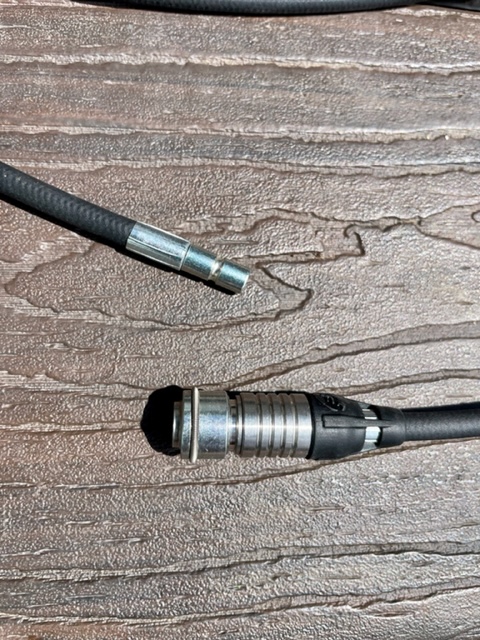
Installing the brake hose to the lever assembly and the Stealth-a-ma-jig was a breeze and used standard SRAM fittings. I ran the hoses through my bars, with the couplers just underneath and close to the stem. The other end of the hoses were easy to run through my frame and fork to the caliper.
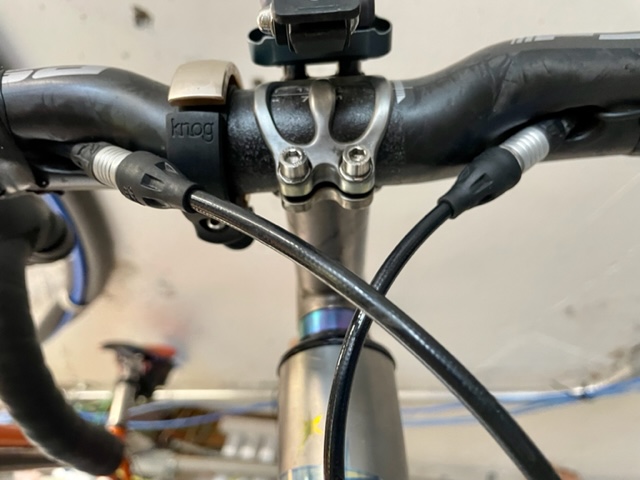
The SRAM eTap single-piece body caliper, however, presents a problem, because not all versions offer a banjo bolt that can be fitted to a different hose. The one-piece calipers use a factory-crimped hose, so if you want to use a Formula Speedlock, you are…hosed. AXS Rival and Force calipers use a nut-and-olive connector at the caliper, so you should be able to use the Formula hose. Note that I have not yet tried this.
The simple solution is to upgrade the brakes while you’re at it. Given that you’ve been upgrading the bike since the pandemic started, there’s no valid reason to stop now, right?
Enter Hope RX-4 brakes. These are a 4-piston brake designed for road and gravel, and are available in both mineral oil and DOT versions (Shimano and SRAM). Although as scarce as hen’s teeth, they have excellent modulation and stopping power. They have great lever feel on SRAM road levers, and are much smoother than the SRAM calipers I’ve used (Force & Red). One item to note is that there are 2 versions: the RX-4 and RX-4+. The + version is newer and uses a different brake pad (the same as on some of their MTB models). Installation of the caliper and Formula hose is very simple and easy.
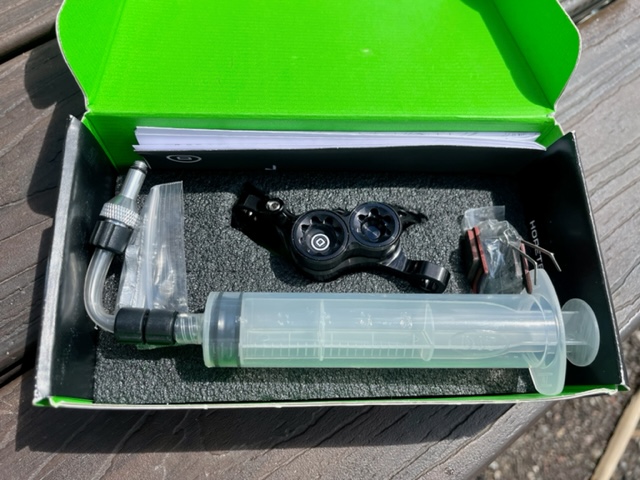
The Hope brake ships with pads, a bleed block, and syringe, so if you buy a pair you have everything you need for installation and bleeding. The pandemic supply issues made them very hard to find, but production seems to be catching up now.
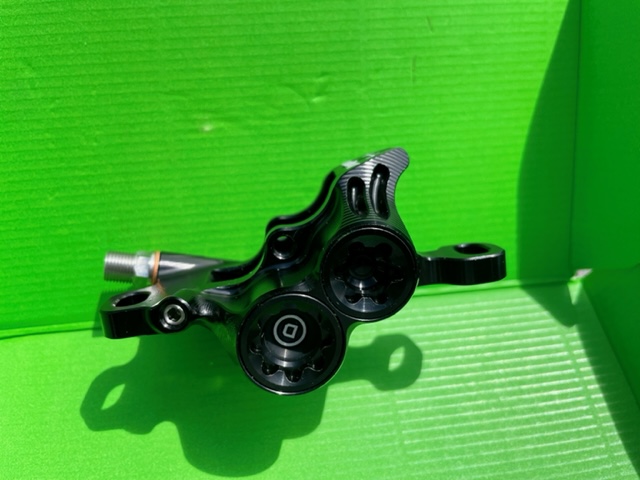
Rotors are another point of discussion. Some people say that you can leave the rotors on the wheels with no problem. Those people are not your friend; they are rotor salesmen who need to meet quota. Take the damn things off, it only takes a minute and will save you headaches when you arrive at your destination. Centerlock rotors are a breeze to remove and install, and with adapters, any 6-bolt rotor will work with a Centerlock hub.
I prefer the Wolftooth Packwrench, and I added the 8mm and cassette sockets to my travel tool kit. The 8mm socket covers stubborn pedals, while the cassette socket will also do centerlock lockrings as well as, um, cassettes. They offer a few other sockets as well. I’m also a fan of their chain pliers and other shiny things they make. The tools are well designed, travel easily, and Wolftooth has excellent customer support.
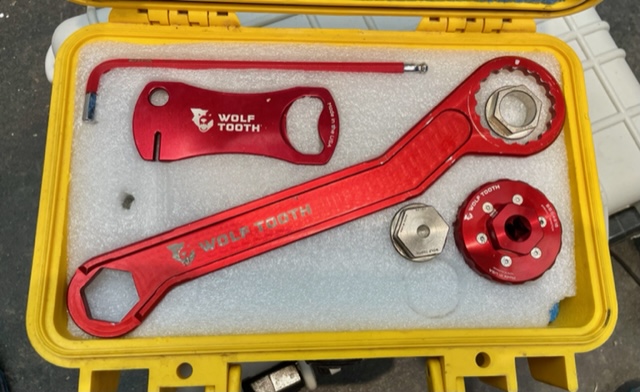
6-bolt rotors and hubs are also not really a big deal, although if you take more than one bike, you can be installing rotor bolts for many hours. The best bet is to make a beer run first. To protect the rotors, I made small pouches out of foam I had on hand, so the rotors slide into a padded sleeve inside my travel case.
These bikes, even though they are configured for travel and disassembly, are still daily drivers. The hose couplers and cable couplers do their duty on every ride, which just backs up the reason we prefer to bring our own stuff on trips. Adding them to the bike is fast and easy, and won’t break the bank. These small changes have a big impact on packing for travel, though, and have made the hotel-based bike shops somewhat better.